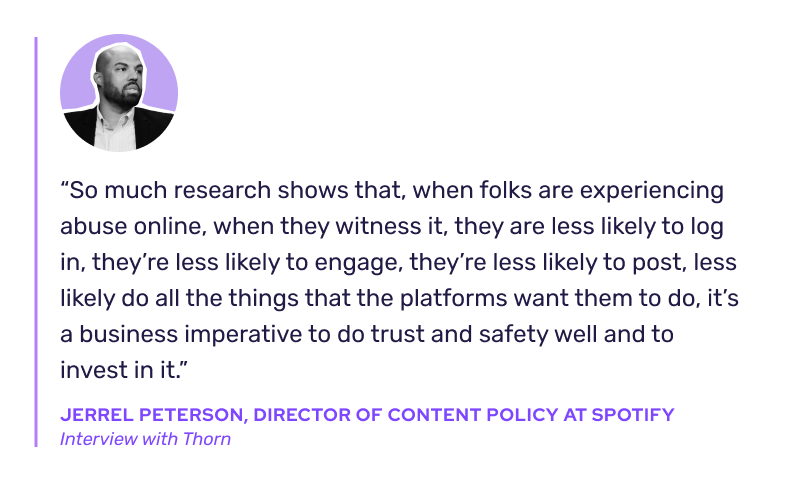“In Reddit’s case, it’s no exaggeration to say content moderation saved the company.” – The New York Times
Once notorious as a venue for some of the internet’s most vile behavior, Reddit’s deliberate Trust & Safety initiatives — from policy updates to moderation to enforcement — elevated the platform to such a degree that it was able to go public earlier this year, raising the company $750 million.
Certainly, a clear boost to the company’s bottom line.
The New York Times wrote, “Reddit’s turnaround proves that content moderation is not an empty buzzword or a partisan plot. It’s a business necessity, [and] a prerequisite for growth…”
Over the last year, we’ve also seen the opposite play out. When Substack chose not to ban “Nazi” and extremist speech, many of its creators threatened to leave the platform. Substack takes a 10% cut of subscriptions from paid newsletters. This means losing just one of its largest creators alone could represent a six-figure loss of revenue, according to the Times.
Trust & Safety (T&S) professionals know that harmful content and behavior are detrimental to a company. When users feel safe on platforms, they stick around and spend money, which in turn attracts advertisers.
T&S pros also know real lives are at stake. Today, child sexual abuse and exploitation are rampant on digital platforms. Trust & Safety initiatives are critical to creating a safe space for users, one free of harmful interactions and content.
Yet, making the case for Trust & Safety resources can be tough. At Thorn, we know it’s been a big topic of conversation as teams grapple with proving ROI in the face of cost-cutting measures and downsizing across the tech industry. To help, we rounded up some ways that teams across the industry are tackling the issue.

Research the impact of harmful content on customer lifetime value
Perhaps the biggest challenge for securing greater Trust & Safety resources is quantifying the impact of harmful environments on key business metrics. The link isn’t always obvious. Yet investigating the ties between metrics can uncover some answers.
At TrustCon 2024, the Spotify team explained their recent investigation into the question: “Does consuming sensitive content cause a decrease in listener lifetime value?” Their research is complex and ongoing, but the team hopes to create a repeatable framework that can estimate the total value of safety across the company.
By picking a metric — say, ad revenue, subscriptions, customer satisfaction (CSAT) scores, or canceled accounts — teams can structure a research framework that follows the link between metrics, ultimately quantifying the impact.
This approach can provide highly valuable data that gets the attention of C-Suite. Still, it’s a resource-intensive initiative, requiring an understanding of methodologies, as well as, potentially, time to repeat studies across content types, policies, and markets.

Show how harmful content drives up acquisition and operational costs
Let’s say a company finds that harmful content does decrease a user’s LTV. Now, if that user ultimately leaves the platform because of that content, the company must also pay to replace that user. Customer acquisition is expensive, as is building a valuable relationship with a brand new user.
Costs caused by the impacts of harmful content are often easier to quantify.
From the time spent investigating user reports to each touch point needed to address a complaint ticket, teams across departments may incur costs dealing with users’ reactions to harmful interactions on a platform.
It’s also important to note, many users never signal their negative experiences to the platform. Thorn’s research shows that many children who have an unwanted sexual interaction online never report it. Thus, being proactive against problematic content and behavior ensures platforms not only reduce associated costs, but prevent the loss of users due to negative experiences the platform’s not even aware of. User churn is one of the most costly business expenses. Worse, enough churn can elicit attention from the media, resulting in an erosion of brand reputation — and quite often, high PR costs.

“So much research shows that, when folks are experiencing abuse online, when they witness it, they are less likely to log in, they’re less likely to engage, they’re less likely to post, less likely do all the things that the platforms want them to do, it’s a business imperative to do trust and safety well and to invest in it.”
—Jerrel Peterson, Director of Content Policy at Spotify, interview with Thorn

The do-it-because-it’s-right argument
“Sometimes we have to invest in Trust & Safety because it’s the right thing to do, not because there will be a return on the investment,” writes Alice Hunsberger in Everything in Moderation.
Trust & Safety professionals know that at times their goals are at odds with business metrics. Reducing exposure to content may mean reducing click rates or time-on-page, KPIs that drive ad revenue. And when metrics compete with metrics, business goals will often take precedence.
So instead of all this number crunching, Trust & Safety teams can wield the company-ethos argument: Do it because it reflects our company’s core values.
VSCO is one such company that has long adhered to its Safety by Design ethos. As the company grew, it invested in infrastructure that safeguards against harmful content, ensuring that its community of creators isn’t exposed to it.
VSCO can tout this commitment, which helps shape positive brand perception to current and prospective users, all the while nurturing a safe environment on its platform.
What makes sense for your team and business goals
Ultimately, the way your team advocates for Trust & Safety will depend largely on your goals and current resources. Shifting the perception of Trust & Safety from a cost center to a growth driver is not easy. But as the Reddit example shows, it can quite possibly save — and even grow — a company’s bottom line. Not to mention, it’s just the right thing to do.


